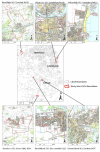The foodscape: classification and field validation of secondary data sources across urban/rural and socio-economic classifications in England
- PMID: 22472206
- PMCID: PMC3341208
- DOI: 10.1186/1479-5868-9-37
The foodscape: classification and field validation of secondary data sources across urban/rural and socio-economic classifications in England
Abstract
Background: In recent years, alongside the exponential increase in the prevalence of overweight and obesity, there has been a change in the food environment (foodscape). This research focuses on methods used to measure and classify the foodscape. This paper describes the foodscape across urban/rural and socio-economic divides. It examines the validity of a database of food outlets obtained from Local Authority sources (secondary level & desk based), across urban/rural and socio-economic divides by conducting fieldwork (ground-truthing). Additionally this paper tests the efficacy of using a desk based classification system to describe food outlets, compared with ground-truthing.
Methods: Six geographically defined study areas were purposively selected within North East England consisting of two Lower Super Output Areas (LSOAs; a small administrative geography) each. Lists of food outlets were obtained from relevant Local Authorities (secondary level & desk based) and fieldwork (ground-truthing) was conducted. Food outlets were classified using an existing tool. Positive predictive values (PPVs) and sensitivity analysis was conducted to explore validation of secondary data sources. Agreement between 'desk' and 'field' based classifications of food outlets were assessed.
Results: There were 438 food outlets within all study areas; the urban low socio-economic status (SES) area had the highest number of total outlets (n = 210) and the rural high SES area had the least (n = 19). Differences in the types of outlets across areas were observed. Comparing the Local Authority list to fieldwork across the geographical areas resulted in a range of PPV values obtained; with the highest in urban low SES areas (87%) and the lowest in Rural mixed SES (79%). While sensitivity ranged from 95% in the rural mixed SES area to 60% in the rural low SES area. There were no significant associations between field/desk percentage agreements across any of the divides.
Conclusion: Despite the relatively small number of areas, this work furthers our understanding of the validity of using secondary data sources to identify and classify the foodscape in a variety of geographical settings. While classification of the foodscape using secondary Local Authority food outlet data with information obtained from the internet, is not without its difficulties, desk based classification would be an acceptable alternative to fieldwork, although it should be used with caution.
Figures
Similar articles
-
Examining the validity and utility of two secondary sources of food environment data against street audits in England.Nutr J. 2017 Dec 20;16(1):82. doi: 10.1186/s12937-017-0302-1. Nutr J. 2017. PMID: 29262827 Free PMC article.
-
Comparing the accuracy of two secondary food environment data sources in the UK across socio-economic and urban/rural divides.Int J Health Geogr. 2013 Jan 17;12:2. doi: 10.1186/1476-072X-12-2. Int J Health Geogr. 2013. PMID: 23327189 Free PMC article.
-
Field validity and spatial accuracy of Food Standards Agency Food Hygiene Rating scheme data for England.J Public Health (Oxf). 2021 Dec 10;43(4):e720-e727. doi: 10.1093/pubmed/fdaa172. J Public Health (Oxf). 2021. PMID: 32970123 Free PMC article.
-
Folic acid supplementation and malaria susceptibility and severity among people taking antifolate antimalarial drugs in endemic areas.Cochrane Database Syst Rev. 2022 Feb 1;2(2022):CD014217. doi: 10.1002/14651858.CD014217. Cochrane Database Syst Rev. 2022. PMID: 36321557 Free PMC article.
-
Correlates of English local government use of the planning system to regulate hot food takeaway outlets: a cross-sectional analysis.Int J Behav Nutr Phys Act. 2019 Dec 9;16(1):127. doi: 10.1186/s12966-019-0884-4. Int J Behav Nutr Phys Act. 2019. PMID: 31818307 Free PMC article. Review.
Cited by
-
Foodscape: A scoping review and a research agenda for food security-related studies.PLoS One. 2020 May 20;15(5):e0233218. doi: 10.1371/journal.pone.0233218. eCollection 2020. PLoS One. 2020. PMID: 32433690 Free PMC article.
-
Area deprivation and the food environment over time: A repeated cross-sectional study on takeaway outlet density and supermarket presence in Norfolk, UK, 1990-2008.Health Place. 2015 May;33:142-7. doi: 10.1016/j.healthplace.2015.02.012. Epub 2015 Apr 2. Health Place. 2015. PMID: 25841285 Free PMC article.
-
Validity of secondary retail food outlet data: a systematic review.Am J Prev Med. 2013 Oct;45(4):462-73. doi: 10.1016/j.amepre.2013.06.009. Am J Prev Med. 2013. PMID: 24050423 Free PMC article.
-
Field validation of secondary data sources: a novel measure of representativity applied to a Canadian food outlet database.Int J Behav Nutr Phys Act. 2013 Jun 19;10:77. doi: 10.1186/1479-5868-10-77. Int J Behav Nutr Phys Act. 2013. PMID: 23782570 Free PMC article.
-
Assessing the validity of commercial and municipal food environment data sets in Vancouver, Canada.Public Health Nutr. 2017 Oct;20(15):2649-2659. doi: 10.1017/S1368980017001744. Epub 2017 Aug 17. Public Health Nutr. 2017. PMID: 28816109 Free PMC article.
References
-
- Giskes K, Avendaňo M, Brug J, Kunst AE. A systematic review of studies on socioeconomic inequalities in dietary intakes associated with weight gain and overweight/obesity conducted among European adults. Obes Rev. 2010;11:413–429. - PubMed
Publication types
MeSH terms
Grants and funding
LinkOut - more resources
Full Text Sources
Medical



